Identity and access management (IAM) tools are software solutions that manage digital identities and their access to resources in an organization. They help organizations to control and manage user access to critical information and systems.
With the constantly rising complexity of IT environments and as cyberthreats continue to increase, choosing the right IAM tool becomes even more high-stakes.
Featured Partners
To help you make such an important decision, here are our picks for the top 8 IAM tools and software in 2023:
- Okta: Best for an extensive network of integrations (Read more)
- JumpCloud: Best for cloud-based directory service (Read more)
- Auth0: Best for customizability and flexibility (Read more)
- Microsoft Entra ID: Best for Microsoft ecosystem (Read more)
- Ping Identity: Best for a balance of user experience and security (Read more)
- SecureAuth IdP: Best for adaptive authentication (Read more)
- OneLogin: Best for simplified access management (Read more)
- CyberArk: Best for IDaaS and privileged access management (Read more)
Table of Contents
Top IAM software comparison
Before diving into individual reviews, let’s compare these IAM tools based on key features that are most relevant to potential users.
| SSO | MFA | RBAC | Adaptive authentication | Compliance management | Starting price | |
|---|---|---|---|---|---|---|
| Okta | Yes | Yes | Yes | Yes | Yes | $2/user/mo. |
| JumpCloud | Yes | Yes | Yes | Yes | Yes | $2/user/mo. |
| Auth0 | Yes | Yes | Yes | Yes | Yes | $23/mo. |
| Microsoft Entra ID | Yes | Yes | Yes | Yes | Yes | $6/user/mo. |
| Ping Identity | Yes | Yes | Yes | Yes | Yes | $3/user/mo. |
| SecureAuth | Yes | Yes | Yes | Yes | Yes | Contact sales for quote |
| OneLogin | Yes | Yes | Yes | Yes | Yes | $4/user/mo. |
| CyberArk | Yes | Yes | Yes | Yes | Yes | Contact sales for quote |

Okta
Best for an extensive network of integrations
Okta channels the power of the cloud to offer flexible access to applications regardless of device and time and enforce robust security protocols. It does this through a powerful and extensible platform that focuses on identity. Okta excels in providing a wide range of integrations and robust multi-factor authentication (MFA) features. It’s a top choice for organizations that require extensive network integrations.
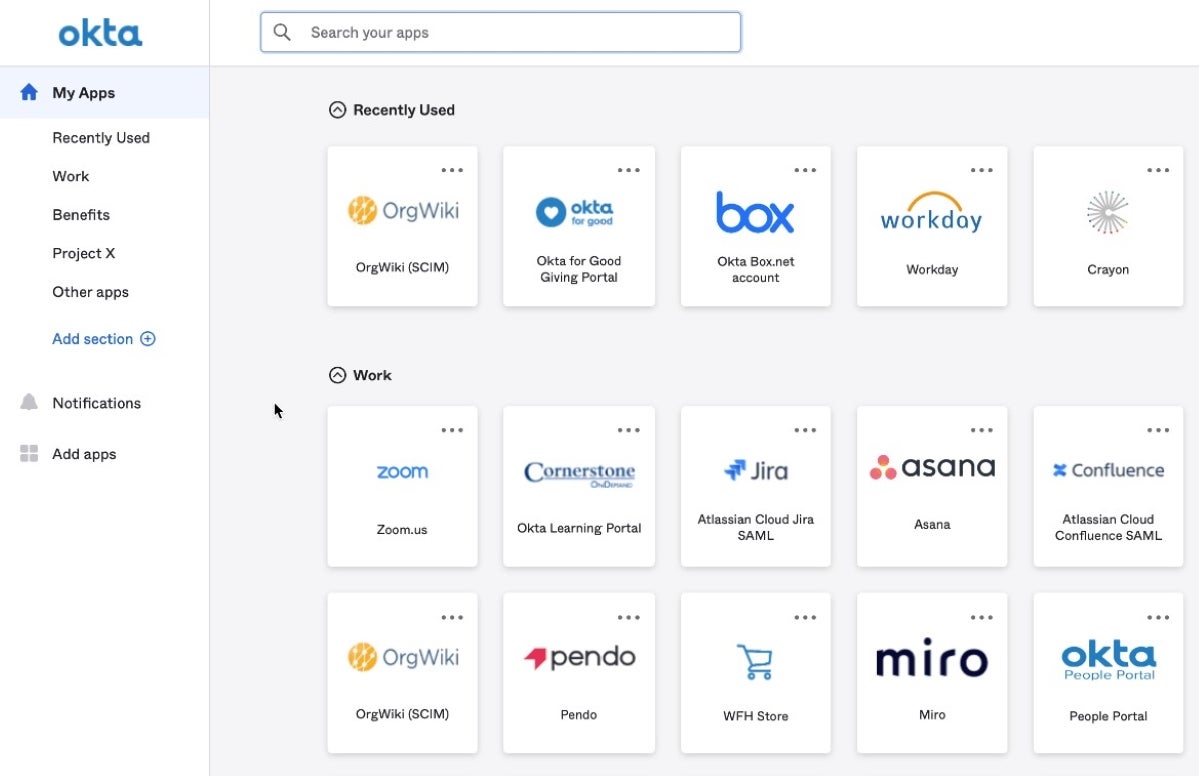
Pros and cons
| Pros | Cons |
|---|---|
| 7,000+ integrations. | Cumbersome device switching. |
| Robust MFA. | Can be complex for users with simple IT needs. |
| Adaptive security policies. | High cost for small businesses. |
Pricing
Okta’s pricing covers two tiers, Workforce and Customer Identity Cloud. The former offers a range of products whose prices range between $2 to $15 per user per month while the latter offers three products; B2B plans starting at $130 monthly, B2C plans starting at $23 monthly, and enterprise plans that require you to contact Okta sales.
Features
- Single sign-on (SSO) to provide seamless access to multiple applications with a single set of credentials.
- MFA enhances security by requiring multiple verification forms before granting access.
- Adaptive security policies automatically adjust security measures based on user behavior and risk factors.
- Okta AI uses AI for Identity to offer enterprises threat protection and empower developers to build solutions.

JumpCloud
Best for cloud-based directory service
JumpCloud is revolutionizing the directory service landscape by offering a cloud-native solution. It eliminates the need for on-premises Active Directory and LDAP servers, providing a unified platform for user management. Businesses looking to streamline their directory services without the hassle of maintaining physical servers will find this one particularly intriguing.
Pros and cons
| Pros | Cons |
|---|---|
| Cloud-native directory service. | Limited built-in reporting tools. |
| Extensive APIs and integrations. | Learning curve may be steep. |
| Zero trust security model. | Costly for organizations with limited budgets. |
Pricing
JumpCloud offers a free version for up to 10 users, with premium pricing plans like A La Carte at $2, SSO Package at $7, Core Directory Package, at $11, JumpCloud Platform at $15 and PlatformPlus at $18, all per user per month billed annually.
Features
- Centralized user management for seamless integration with virtually any IT resource, including legacy applications.
- Cloud LDAP eliminates the need for on-prem LDAP servers, offering cloud-based directory services instead.
- Cloud RADIUS provides a cloud-based RADIUS server that integrates with your existing infrastructure, reducing setup time.
- MFA supports TOTP and security keys, offering flexibility in secure access methods.

Auth0
Best for customizability and flexibility
Auth0, an independent product within Okta, stands out for its high level of customizability that gives businesses the flexibility to tailor their authentication processes. With a rich set of APIs and SDKs, it’s a developer-friendly platform that’s adaptable to complex use cases. The extensive documentation makes it easier for the platform to meet your organizational needs.
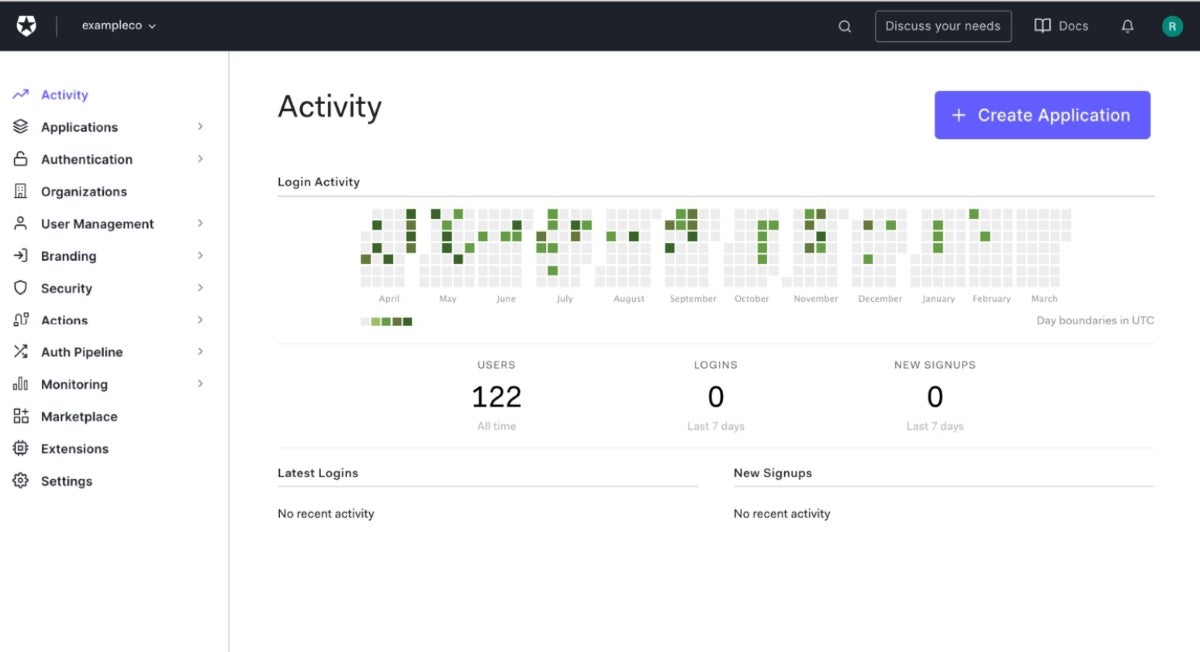
Pros and cons
| Pros | Cons |
|---|---|
| Highly customizable and flexible. | Deployment can be complex. |
| Rich set of APIs and SDKs. | Limited language support. |
| Extensive documentation and support. | A challenge building multi-tenant applications. |
Pricing
Aside from a free plan, Auth0 premium plans are based on B2C, B2B, and B2E use cases. B2C ranges from $23 to $240 per month for 1,000 monthly active users; B2B is between $130 and $800 per month for 500 active users, while B2E requires you to contact Auth0 for a quote.
Features
- Universal Login offers passwordless login with biometrics and multiple MFA methods.
- SSO capabilities streamline user access across various applications.
- Customizable login services adapt to your business, technology, and customer base.
- Auth0 Dashboard and Management API for seamless, scalable product configuration.

Microsoft Entra ID
Best for Microsoft ecosystem
Microsoft Entra ID, formerly Microsoft Azure Active Directory, is an enterprise-level identity service that offers seamless integration with other Microsoft products. If your organization is already invested in the Microsoft ecosystem, Entra ID is an ideal choice, providing a cohesive and streamlined user management experience. It also offers robust security features, making it a thorough solution for identity and access management.

Pros and cons
| Pros | Cons |
|---|---|
| Seamless Microsoft integration. | Complexity in non-Microsoft environments. |
| Robust security features. | Licensing can be confusing. |
| Highly mature and scalable solution. | Higher cost for premium features. |
Pricing
In addition to a free plan, Entra ID’s pricing starts at $6 per user per month for its P1 plan, $9 per user per month for P2, and $7 per user per month for the Governance plan.
Features
- Secure adaptive access protects resources and data using strong authentication and risk-based adaptive access policies.
- Seamless user experiences offer a fast, easy sign-in across a multi-cloud environment to boost productivity.
- Unified identity management centralizes all identities and application access in one location for improved visibility and control.
- Passwordless and multi-factor authentication secure access to data and apps, eliminating the inherent risks of passwords.

Ping Identity
Best for a balance of user experience and security
Ping Identity focuses on providing both a secure and user-friendly experience through an intelligent platform. It offers solutions like SSO and MFA without compromising on user convenience. Users can even design workflows through Ping’s drag-and-drop capabilities. For a balance between robust security and ease of use, Ping Identity is a strong choice.

Pros and cons
| Pros | Cons |
|---|---|
| Robust security features. | Setup can be complex. |
| Adaptive risk management. | Pricing can be complicated. |
| Extensive third-party integrations. | Very technical documentation. |
Pricing
PingOne for Customers’ pricing starts at $20,000 per year while PingOne for Workforce Starts at $3 per user per month.
Features
- Orchestration capabilities enable seamless, automated workflows across applications and some identity systems.
- Threat protection prevents identity fraud without sacrificing user experience, using advanced analytics.
- Profile management securely handles identity and profile data at scale, offering granular control.
- Identity verification ensures customer identities are verified during registration and beyond, using multiple methods.

SecureAuth IdP
Best for adaptive authentication
SecureAuth IdP supports flexible and secure authentication experiences for workforce, customers, and partners. It excels in adaptive authentication, offering a dynamic approach to security that adjusts based on various risk factors. SecureAuth’s Identity Platform is designed to reduce friction for legitimate users while stopping attackers in their tracks, which makes it a worthy consideration for organizations that value flexible yet robust security measures.
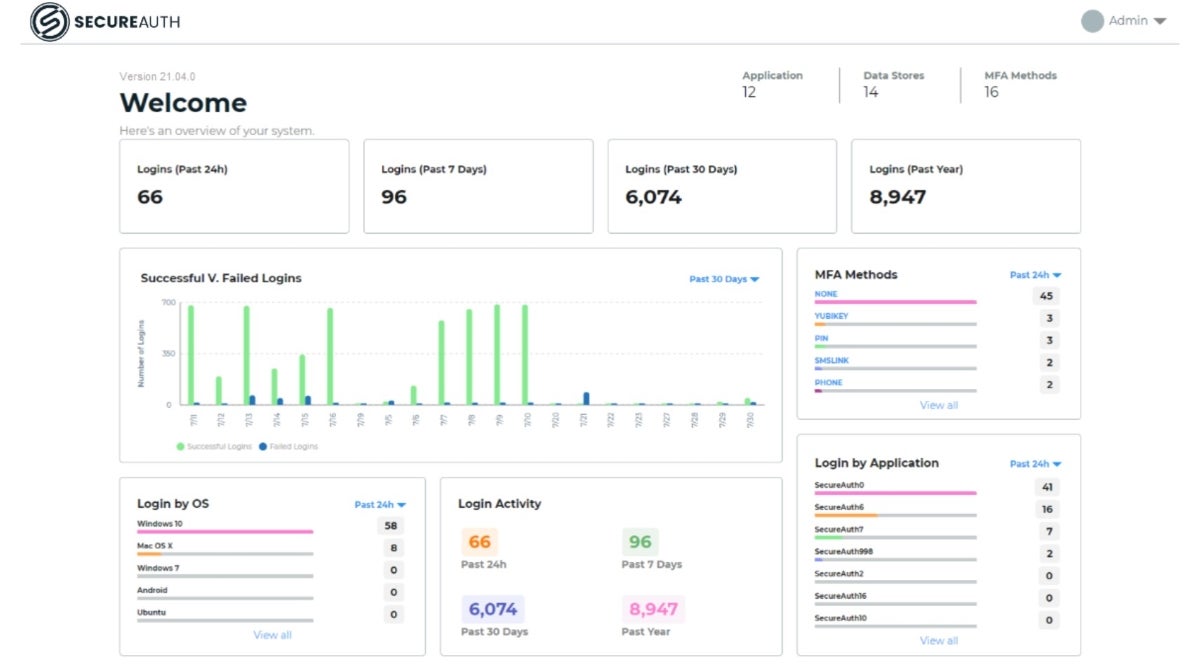
Pros and cons
| Pros | Cons |
|---|---|
| Adaptive authentication risk checks. | Learning curve may be steep. |
| Supports multi-cloud deployments. | Advanced features may need more technical capabilities. |
| Lots of options for MFA methods. | Limited support for certain features. |
Pricing
For SecureAuth pricing information, you’ll have to contact their sales team as it’s not publicly listed.
Features
- Adaptive Authentication analyzes device, location, IP address, and behavior to make better access decisions.
- Nearly 30 MFA methods offer a wide range of options tailored to different user types and systems.
- User self-service tools maintain productivity and reduce help desk calls.
- Standards-based architecture optimizes existing security investments with reusable objects.

OneLogin
Best for simplified access management
OneLogin is an IAM tool that seeks to simplify the complex access management landscape by focusing on ease-of-use and quick deployment. This makes it ideal for businesses that want to get up and running quickly without compromising on security. Additionally, its unified access management platform streamlines the user experience across all devices.
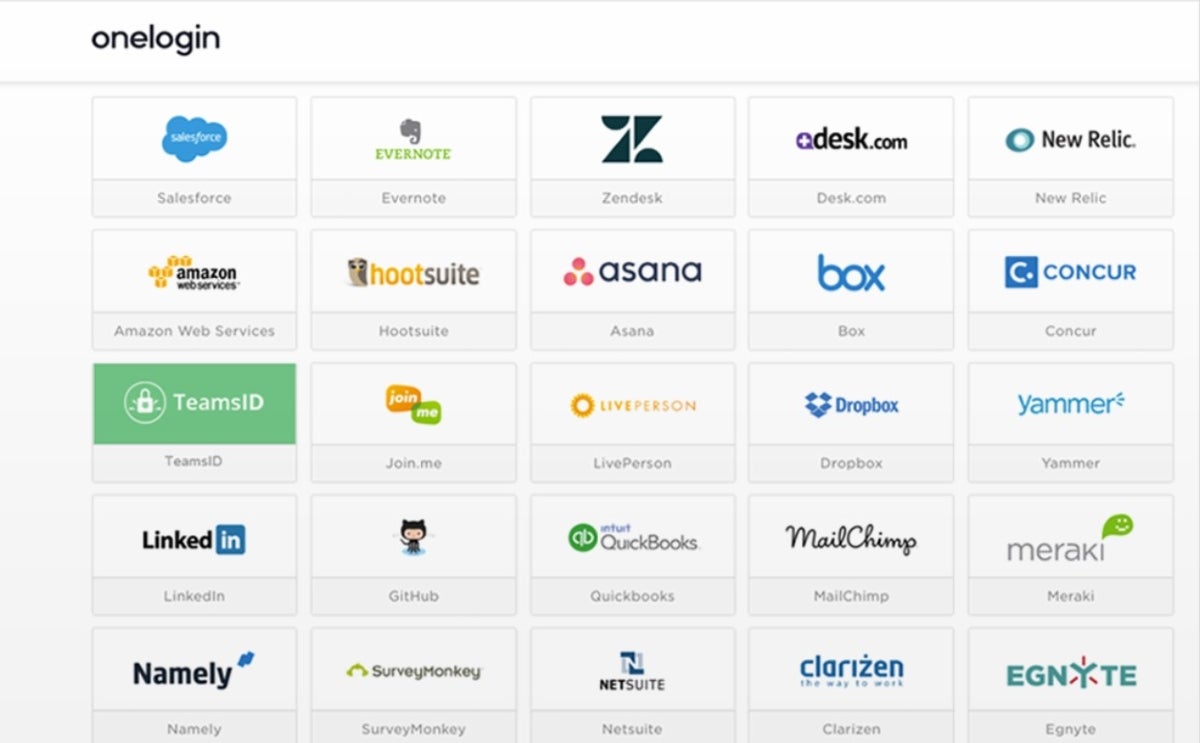
Pros and cons
| Pros | Cons |
|---|---|
| Easy to use and deploy. | UI can be unintuitive. |
| Unified access management. | Occasional latency issues reported by users. |
| Strong MFA options. | Limited customization options. |
Pricing
For the Advanced and Professional tiers of its Workforce Identity product, OneLogin’s pricing starts at $4 and $8 per user per month respectively. However, for the Customer Identity product, contact sales for pricing information.
Features
- Cloud directory syncs users from multiple directories like Workday, Active Directory, and G Suite.
- SSO offers one-click access to all apps, both in the cloud and on-premises.
- SmartFactor Authentication uses risk insights from Vigilance AI to prevent cyberthreats with context-aware adaptive authentication.
- Identity and lifecycle management aligns user and application management for automated on- and off-boarding.

CyberArk
Best for IDaaS and privileged access management
CyberArk is a leader in privileged access management, making it a go-to solution for dynamic enterprises that need a security-first approach to identity security. Organizations that need to manage many privileged accounts and sensitive data will find CyberArk to be of interest.
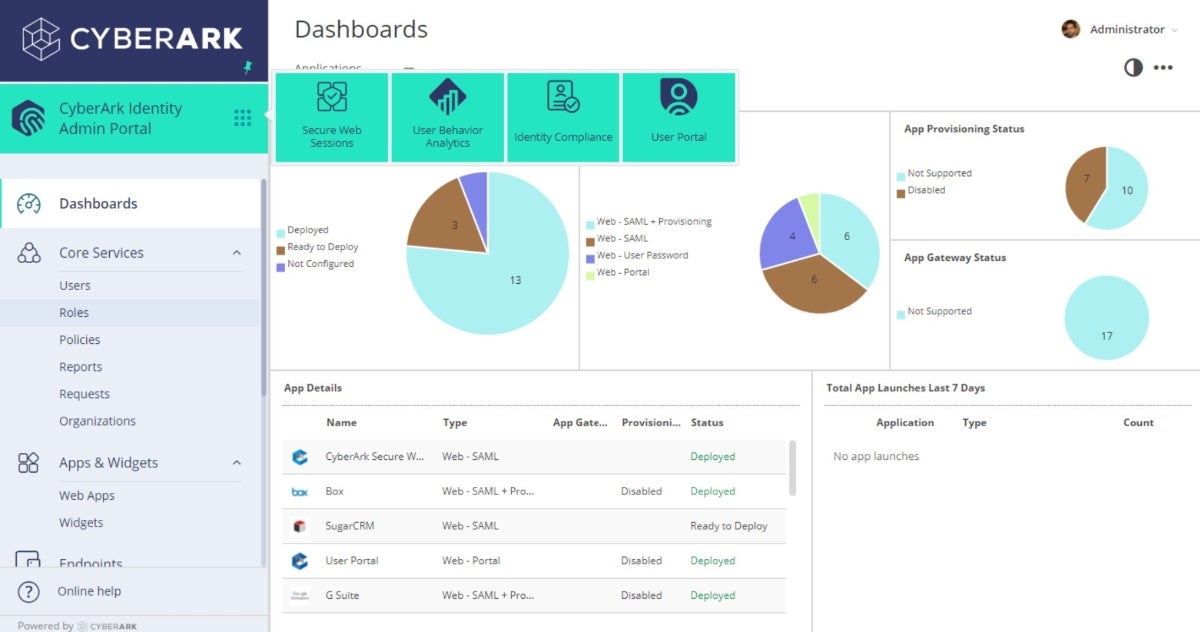
Pros and cons
| Pros | Cons |
|---|---|
| Strong privileged access management. | High cost of ownership. |
| Detailed auditing and compliance reports. | Complex to set up and maintain. |
| Enterprise-level security. | Limited MFA options. |
Pricing
While it does not list its pricing publicly, CyberArk invites prospective users to sign up for free trials and demos for a feel of the product and talk to CyberArk experts for pricing information.
Features
- Continuous discovery and management of privileged accounts across multiple environments.
- Least privilege enforcement on Windows and Mac desktops, as well as Windows servers.
- AI-powered detection and remediation of hidden or misconfigured permissions in cloud environments.
- Session recording and auditing with a searchable log for real-time monitoring and compliance.
Key features of IAM software
When selecting an IAM solution, you should always consider the features that align with your organization’s needs. Some key features to look out for include SSO, MFA, RBAC, adaptive authentication, and compliance management.
Single sign-on (SSO)
With SSO, the login process is made easier as users can use one set of credentials to access multiple services. This improves user experience while reducing the risk of password-related breaches.
Multi-factor authentication (MFA)
MFA adds an extra layer of security by requiring multiple forms of verification before granting access. This makes it that much harder for unauthorized users to gain access.
Role-based access control (RBAC)
RBAC allows administrators to set permissions based on roles within an organization. This ensures that users have appropriate access to the resources they need, and not the ones they don’t — thereby enhancing compliance and security.
Adaptive authentication
Adaptive authentication adjusts the authentication process based on risk factors like user behavior, device, and location. This provides a healthy balance between security and user convenience.
Compliance management
Compliance management features help organizations adhere to legal and regulatory requirements. This is crucial for businesses in sectors like healthcare, finance, and government, where data protection regulations are stringent.
How to choose the best IAM software for your business
Choosing the right IAM software goes beyond just comparing a list of features. There are a variety of other factors you’ll want to take into consideration:
- Integration: First, ensure that the tool integrates seamlessly with your existing systems and applications for a unified security approach.
- Scalability: Opt for a solution that can adapt and grow with your organization.
- User experience: A complicated or unintuitive interface can lead to user errors, posing a security risk in addition to lost productivity.
- Budget: While cost is always a consideration, it’s important to remember that opting for a cheaper solution could end up being more costly in the event of a security breach.
Above all, your choice will be guided by your use case and your distinct needs.
How we evaluated IAM software
To deliver the comparison of the eight tools listed above, we first established the features that should be part of a great IAM tool today.
In looking at the feature sets of the tools, we compared how each tool approaches each feature, with a focus on how robust each tool’s security features are, as IAM’s key function is to enhance security.
We then assessed the user experience of the tools, which was greatly assisted by demos and trials as well as feedback from verified user reviews.
Finally, we considered the cost of each tool as cost is a major purchasing factor. All these put together gave us a balanced evaluation of IAM software.
Frequently Asked Questions (FAQs)
What are the components of identity access management?
IAM solutions can include a variety of different elements all working together to guard and manage access based on user identity, but most include the features listed above, such as SSO, MFA, RBAC, and adaptive authentication.
Should my IAM solution be centralized or decentralized?
A centralized IAM solution is easier to manage but may create a single point of failure. A decentralized system can offer more robust security but may be more challenging to manage. The choice will ultimately come down to your business’ infrastructure and needs, such as the size and skill of your IT department, your budget, and any particular industry considerations such as compliance, risks, and regulations.
Is IAM the same as PAM?
No, IAM (Identity and Access Management) is a broader term that includes various features like SSO and MFA. PAM (Privileged Access Management) is a specific element of IAM and focuses on managing privileged accounts.
Bottom line: IAM tools protect your critical data
To have oversight over access to your organization’s resources, IAM tools are key. The right one will depend on what your organization needs, including the level of security required, the size of your organization, and your budget. By considering the comparisons in this guide, you can make an informed decision.
For a more general understanding of network security, read our network security guide and learn about all the types of network security solutions you can implement for a complete, holistic defense.





